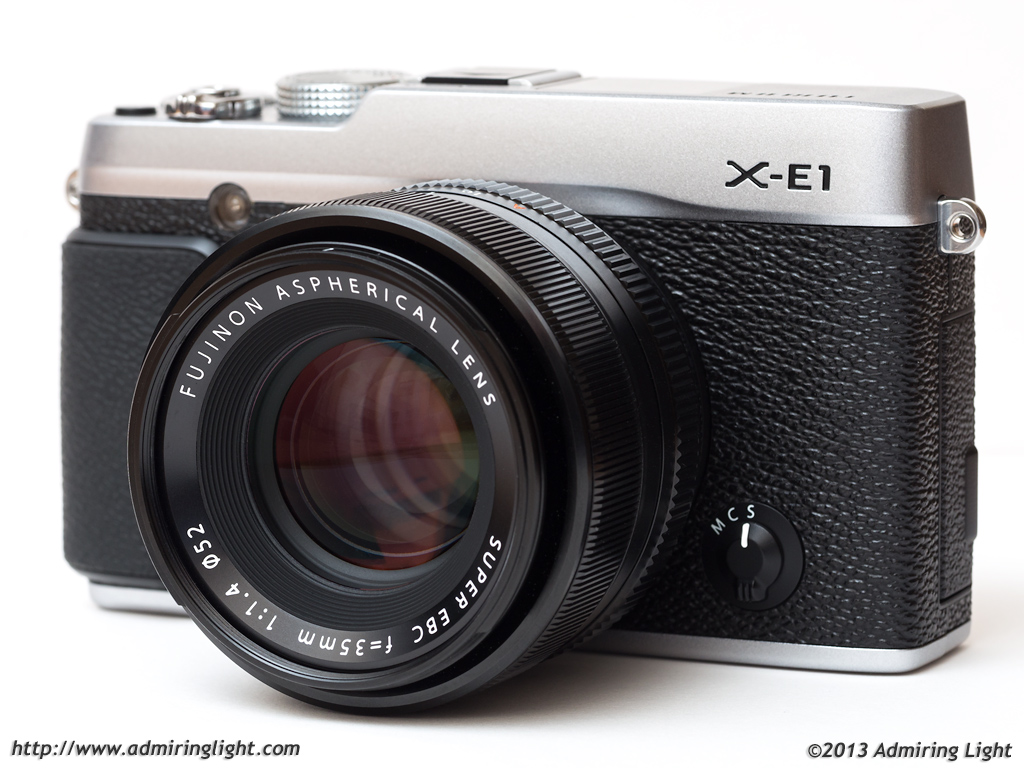Contents
Image Quality: Resolution, Dynamic Range and Color
The X-E1 is an interesting character with regards to image quality, primarily due to some of the controversy about the X-Trans sensor that Fuji uses. The X-Trans sensor uses a non-Bayer filter array to capture detail and color, and this has the supposed benefit of increased detail without moire due to the ability to eliminate the low pass filter that is found on most other digital cameras. In my shooting, I haven’t found the X-E1 to have any greater detail than any other 16 megapixel camera. With a sharp lens, it is certainly capable of resolving impressive amounts of detail, but no more than any other sensor I’ve used with similar resolution. The downside to the X-Trans sensor is that it requires completely different demosaicing algorithms when processing RAW files, and there are some instances where this process results in odd painterly artifacts. While recent versions of Adobe Lightroom and Camera Raw as well as Phase One’s Capture One 7 have addressed this issue and minimized the effect, it can still crop up if you really look for it. I don’t think with current situations, though, that it impacts most shots, and in the few shots where it is slightly visible, it wouldn’t show up in a print or screen reduction.

The dynamic range of the Fujifilm X-E1 is absolutely stunning. The RAW files of the X-E1 are calibrated a little to the right, so you do need to watch your highlights a little when you’re picking your exposure, but the shadow well is deep…there is a tremendous amount of detail in the shadows of RAW files, and if you use the gentle highlight and shadow settings in JPEG, you get a lot of this dynamic range in the JPEG files as well. The shot to the right is taken near noon, shooting towards the sun. While I wanted to maintain a balance between shadow and highlight in the final image, I can bring up the shadows enough to see clear detail in the deepest shadows of the bike rack roof (even seeing threads on the bolts).
Color on the X-E1 is quite good, though very muted in the RAW files by default. Usually, I need to push saturation up quite a bit when shooting RAW, but the files hold up beautifully, and the files have a wealth of color data to use. In JPEG modes, there are a number of film simulations that produce really beautiful colors right out of camera.
This all adds up to a real wonderful depth to the images, with great tonal response and very nice rolloff of the highlights. I love the overall look of the images, and despite the quirks of the body, it’s the final file that keeps me shooting with this camera.

Image Quality: Noise
Overall, the Fujifilm X-E1 provides very good noise control for an APS-C camera. Images are quite clean straight through ISO 800, and even 1600 and 3200 only have a little noise that’s pretty easy to clean up. I find that ISO 6400 is eminently usable, though a little rougher. ISO 12,800-25,600 are only accessible via JPEG shooting, but even these yield usable files for smaller prints and web use.
At base ISO, the camera produces extremely clean images. Skies are clear blue without noise and even shadows are nice and clean.
One thing of note is that the ISO for the Fuji X-E1 is slightly under-rated. The meter tends to expose a little brighter than most other cameras, so relying on the metering will yield slower shutter speeds in addition to the lower rated ISO, but I found the X-E1 to be about a 1/3 stop darker at the same ISO, shutter speed and aperture than my other cameras. Still, even accounting for the 1/3 stop lower ISO rating, the X-E1 is about a full stop better in the noise department than my Olympus OM-D E-M5.
JPEG Quality
I normally don’t cover JPEG quality all that much, but Fuji deserves special mention here. The out of camera JPEGs are utterly fantastic from the X-E1. If it weren’t for my desire for absolute control over my images, I could shoot JPEG all day long and not give it a second thought. Images have very low compression, look clean and detailed and the film simulation modes give great options from a softer, more muted Astia simulation, to the bold and vibrant Velvia simulation, you can get a look and adjust the parameters to work how you want.
I actually use JPEGs out of camera a fair bit, though usually not shooting in JPEG mode, but rather as in-camera conversions using the in-camera RAW conversion capabilities, which I’ll discuss next.
Video
As I noted at the beginning of the review, I’m not a videographer, so I’m not really qualified to discuss the intricacies of the video quality. I have used the video features a bit, and the X-E1 can shoot 1080p video, though control is limited to pre-shooting settings. Once you start recording, you can’t change aperture or exposure compensation. Video quality is pretty good, though not on the level of the best cams in this area. The X-E1 is geared towards stills use, and the video mode is nice to have when you want to shoot relatively high quality video when your’e out, but if you plan on shooting high quality video as a main feature, you’ll probably want to look elsewhere.


This is a very thorough review! Thanks.
I find the Fuji X cameras very photography focused. When I pick my Canon dslr, or a P&S, even a m4/3 I feel I need to look at menus, options, change settings. With my X-E1 I can just pick it up and shoot.
I never really thought I would like manual controls, but they just “feel” right.
Love my X-E1 and both the 18-55 and the 35. I find myself using this camera and lens combo much more often now than my D700, or D800. Who wants to carry a dSLR if they don’t have to? Not me.
I still use the D700 and D800 for tripod work, and weddings but I would not hesitate to take the X-E1 to an event.
Thanks for the review. It is not all rosy — especially the focus issue. I also did not see the “seam” issue on my X-E1 body that you show in your images. That’s weird. Maybe they fixed this QC issue?
Later,
J
For Jorg!
Love my X-E1 and as 18-55 and 35.
See the difference in picture detail if you shoot at 35 mm focal length lens (XF18-55mm F2 ,8-4 R LM) against XF35mmF1.4 R.
Sincerely,
Victor
I think it is a major quirk that you need to press the AF-Button in order to be able to move the focus area.
While looking through the EVF this is just awkward.
The AE-Button is somewhere between my nose and my cheek and I have a hard time to find it without taking the camera down.
Don’t you have the same problem?
I do say ” The only odd ergonomic item is the positioning of the AF button, which is a little awkwardly placed at the left edge. I’d have prefered a top plate or thumb accessible button for this, so that it was easier to change the focus point while the viewfinder is up to your eye.”
You are right, sorry, I missed that one.
However why do I need an extra button?
On my 7D I can move the focus points without pressing any extra buttons.
Even if I have to press an extra button: The buttons up, left and right of the selector all already taken, but the button down is available: Pressing the down button once enters the focus selection mode.
I just hope somebody at Fuji reads your blog and changes that in the next firmware update.
BTW: You have created some truly beautiful pictures for this review!
What I’d really like is for them to put a touch screen on the back in addition to direct focus point adjustment. I originally thought it was a gimmick, but having owned several touch screen cameras now, it’s truly great to just be able to touch where you want the focus point to be. Even bringing the camera down from your face it’s fast to switch. (Note I’m not wanting a touch screen instead of direct button controls (never), but in addition to…
My biggest hope for the next firmware update (aside from continuing to improve AF) is the fixing of the magnification problem, where you can’t magnify an image in manual focus if the camera is writing to the card. It kills me when I use an adapted lens.
Hi Jordan, great review! I just bought Sonar 90 and have not yet bought the adapter, could you tell me what are you using? Thanks
I’m using a cheap e-bay adapter that looks like a knockoff of the Kipon adapter. It works fine. It turns easily, but can stick a little bit throughout the range. The longer you leave it on, though, the smoother it gets. If you want really smooth focusing, I hear the metabones is the way to go, but it’s heavy and expensive.
Great review, thank you. I am strongly leaning towards a purchase of the X-E1. Fuji has very recently released a software update to address focus issues with both the ProX1 and the X-E1. Was your review with the new update? If not will you be updating and letting us know if it makes as significance a difference as Fuji indicates on their website. Thanks
I’ve been shooting with the latest firmware since I got the camera (1.04). All lenses are up to date as well. The next update that was recently announced won’t be available until the May-July timeframe. If there is a significant change, I’ll update the review at that time.
I’ve been excruciatingly patient in holding off on purchasing one of the new Fuji X-Series cameras. However, this one is starting to talk to me in a big way. Your honest review with not only the good points, but the dirt too, is really an informational dream. I’m still limited on my budget, but I think I can swing into a body-only XE-1 for $600-$700 if I’m just a little patient about it. I find that there is an M42 adapter available, and my old but amazing Zeiss Ultron 50/1.7 screw mount ought to do well in carrying the image to the sensor. Thank you for one of the better reviews I’ve read anywhere.
Hi Jordan. I’m very glad to read this detailed review. If you don’t mind, i’m wonder that what did you apply on first photo above in ps? Thank you.
The latest firmware solves the problem of the awkward placement of the AF button on the lower left of the Fujifilm X-E1. You now have two other choices; the FN button can be programmed to serve that function, as can the lower arrow in the 4-way controller. The latter seems the better choice. Just one click on the lower arrow to open up the focus point screen, then your finger is already in position to make adjustments. It works smoothly.
Yes indeed. That is why, when Firmware 1.06 was released, I added the following text to the review: “Update: With firmware v.1.06, Fuji has added the ability for the down arrow on the four-way controller to act as a programmable function button. By default, this is set to control focus area selection. The Fn button can also now be programmed to allow for focus area selection. Having AF point selection on the down arrow makes selecting the focus point tremendously easier when shooting. Thanks, Fuji!”
Thanks for the nice reviews. They are always well written and supported by some fine images.
I am considering the XE-1 + 27mm f2.8 both of which you have reviewed. One of the reasons is the cropped 1:1 aspect ratio it offers, as an easy alternative to shooting 6×6 film . One question though, how does the cropped 1:1 aspect ratio affect the focal length of the lenses?